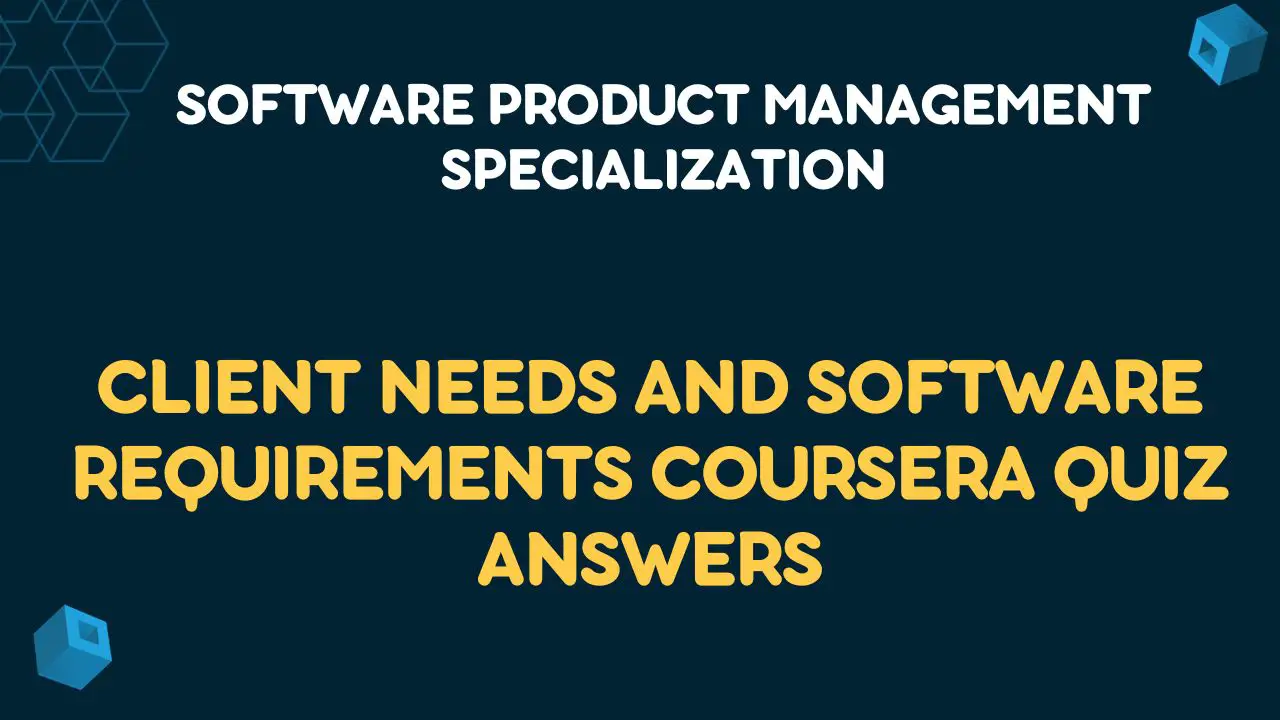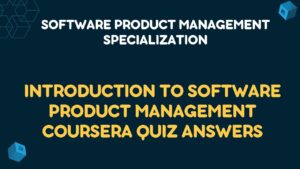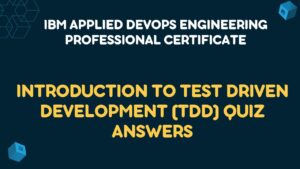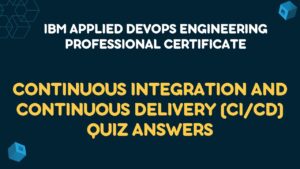Get All Weeks Client Needs and Software Requirements Coursera Quiz Answers
Table of Contents
Module 1 Assessment (Graded) Answers
Q1. Which of the statements below are relevant to the activity of eliciting requirements? (Choose three that apply)
2.Need interaction with the client and end users to define their problem.
3.Involve the client and end users in determining their needs.
Q2. The activity of analyzing requirements involves checking to ensure requirements are:
ViewQ3. Why is there an activity to manage requirements? Choose two that are correct.
View2.So changes to requirements are tracked for impact upon other requirements and work.
Q4. Which are examples of the business rule type of software requirement? Choose two that are correct.
View2.Government regulation
Q5. From the course, which type of requirement describes a task that an end user can do with the software product?
ViewQ6. Which types of non-functional requirements are involved in the following statement? “The mobile application must measure the user’s location 10 times per second, for a period of at least one hour.”
ViewQ7. What does the product vision include? Choose two that are correct.
View2.Placement among competing solutions
Q8. What are acceptable ways to defend against scope creep? Choose two that are correct.
View2.Ask the question, “Is this in scope?”
Module 2 Assessment (Graded) Answers
Q1. End users are ___ users, since they use the product. Their supervisors are ___ users, if they use the product only occasionally or indirectly. Instances of both types of users are ___, since they are affected by the product.
ViewQ2. When forming the requirements for a software product to monitor a person’s physical health, what background characteristics of users should be considered? Choose two that are correct.
View2.Sensory abilities (e.g., sight)
Q3. Ways to elicit requirements from end-users include ___. Choose three that are correct.
View2.end user interviews
3.watching the tasks end users do
Q4. Requirements elicitation is an activity with stakeholders involving interactions that are ___. Choose two that are correct.
View2.balanced
Q5. A use case description defines a task supported by the software product, including the task goal, participating ___ involved in the task, the ___ that must be met once the task is completed normally, and the main steps of the task in the ___.
ViewQ6. Within a use case description, what is the difference between a precondition and a trigger?
ViewQ7. A wireframe used during requirements elicitation is a good way to specify ___.
ViewQ8. Movie-style storyboards can use fictional characters with specific ___ to depict the different types of users, and their goals, behaviors, and characteristics, in the markets to be addressed by the software product.
ViewModule 3 Assessment (Graded) Answers
Q1. Which of the following Agile principles are applicable when exploring stakeholder needs? Choose all that are correct.
View2.Welcome changing requirements, even late in development. Agile processes harness change for the customer’s competitive advantage.
Q2. In which traditional, standard form does a user story express the who, what, and why of a requirement?
ViewQ3. Bill Wake devised the mnemonic INVEST to remember what makes a good user story. The “I” stands for “independent” and the “N” stands for “negotiable”. What do the “V”, “E”, “S”, and “T” stand for?
ViewQ4. Consider the following user story: As a reader, I want to advance to the next article in my reading list by clicking a green button labeled “Next”. Besides missing the reason why, what else is poor about this requirement? Choose two that are correct.
View2.It is not negotiable.
Q5. To verify a user story as completed correctly, an acceptance criterion is a ___ and an acceptance test is a ___.
ViewQ6. When employing the approach of writing user stories on index cards, what is commonly written on the back of the user story card?
ViewQ7. Prior to planning, who determines the effort estimate to complete a user story on the product backlog?
ViewQ8. A story map takes the user stories on the product backlog and organizes them into columns that denote ___ and rows that denote ___.
ViewAmbiguous Requirements Quiz Answers
Q1. Consider the user story, “As a player, I want the machine to make a noise when I gain 100 points, so that I have an auditory signal when I’m doing well.”
Why is this user story considered ambiguous?
ViewQ2. Consider the user story, “As a player, I want the machine to make a noise when I gain 100 points, so that I have an auditory signal when I’m doing well.”
ViewSuggest a better, less-ambiguous way of writing this user story.
Q3. Consider the user story, “As a multiplayer, I want both players to have a controller, so that we can play together.”
Why is this user story considered ambiguous?
ViewQ4. Consider the user story, “As a player, I want to see the name of the player with the highest score everyday, so that I know who has the high score.”
Suggest a better, less-ambiguous way of writing this user story.
ViewQ5. Consider the user story, “As a player, I want the targets to start moving after I press Start, so that I can start hitting them.”
What is the ambiguous word in this user story, and which category of ambiguous words does it belong to?
ViewQ6. Consider the user story, “As a player, I want the targets to start moving after I press Start, so that I can start hitting them.”
Suggest a better, less-ambiguous way of writing this user story.
ViewQ7. Consider the user story, “As a player, I want the screen to always display a target, so that there’s always something to hit.”
ViewQ8. Consider the user story, “As a player, I want the screen to always display a target, so that there’s always something to hit.”
Suggest a better, less-ambiguous way of writing this user story.
ViewQ9. Consider the user story, “As a multiplayer, I want to beat them when I’m playing in versus mode, so that I win the game.”
Why is this user story considered ambiguous? (Select 2 answers)
View2.It does not specify who “them” is in the user story.
Q10. Consider the user story, “As a multiplayer, I want to beat them when I’m playing in versus mode, so that I win the game.”
Suggest a better, less-ambiguous way of writing this user story.
ViewModule 4: Assessment (Graded) Answers
Q1. Considering the requirements criteria, a correct user story means ___.
ViewQ2. An unambiguous user story would be ___, assuming also the terminology and meaning are understood.
ViewQ3. A ___ user story means that whether it was satisfied can be tested.
ViewQ4. A traceable user story mainly means that ___.
ViewQ5. While eliciting requirements with a potential photo editor user, you hear they want to be able to edit the last photo. What should you do next?
ViewQ6. An ambiguous requirement is best resolved by:
ViewQ7. Identify the unambiguous user stories for a blog site. Choose two that are correct. As an author, ___, so that I can correct an entered post.
View2.I want to be able to edit my newest post.
Q8. Identify the problem with the following user story for a restaurant menu app. Choose two that are correct. As a customer, I want to choose a dietary restriction including vegetarian and gluten-free, so that I avoid certain ingredients in my dishes.
View2.Incomplete
Course Assessment (Graded) Answers
Q1. In the course, software requirements are defined as: ___.
ViewQ2. In what form should requirements be expressed?
ViewQ3. What is specifically achieved by the managing requirements activity? Choose two that are correct.
View2.So requirements can possibly have subsets reused in other products.
Q4. Which type of requirement explains why a software product is needed?
ViewQ5. Which are examples of a business rule type of software requirement? Choose two that are correct.
View2.Privacy policy
Q6. From the course, which type of requirement is the following statement?
The application must record the date, time, and beats per minute for a heart rate measurement.
Q7. Requirements can ___, so the ___ must be managed carefully to determine what is in or out of the product.
ViewQ8. What are acceptable ways to defend against scope creep? Choose two that are correct.
View2.Prioritize the requirements.
Q9. While design notations like wireframes and storyboards are useful during requirements elicitation to generate product ideas, what is the main pitfall?
ViewQ10. When forming the requirements for a software product to train a person in different physical exercises, what characteristics of users should be considered? Choose two that are correct.
ViewQ11. What challenging issues could arise when working with end users to form requirements for a new software product? Choose two that are correct.
View2.They may prefer a poor product they already know rather than learn something new.
Q12. To ease understanding with clients and end users, a glossary should be established that everyone agrees with. What kinds of terms should be defined in this glossary?
ViewQ13. You work for a company that makes home automation accessories, and one of the executives has tasked you to create a new mobile app to manage someone’s deployment of the accessories. When eliciting the product’s requirements, what is a good first question to be answered?
ViewQ14. What kind of scenario does the basic flow of a use case description define?
ViewQ15. Why use a wireframe during requirements elicitation? Choose two that are correct.
View2.To help visually in generating the tasks that need to be supported.
Q16. What may be depicted by the two types of storyboards? Choose two that are correct.
View2.States of the product user interface and their navigational relationships
Q17. Consider the following requirement:
The product shall record the starting and ending location for a ground travel expense item of a claimant.
What is an appropriate expression of the requirement in standard user story form?
Q18. What is a key difference between use cases and user stories?
ViewQ19. The traditional, standard form of a user story correspondingly expresses the ___, ___, and ___ of a requirement. Choose two that are correct.
View2.who / what / why
Q20. Consider the following user story:
As a traveler, I want the journal application to have a good user interface, so that I enjoy using it regularly.
What is poor about this requirement? Choose two that are correct.
2.It is an epic.
Q21. Consider the following user story for an application:
As a meal planner, I want to see nutrition information for a given amount of a specific food, so that I prepare a healthy meal.
What are suitable acceptance tests? Choose two that are correct.
2.Enter 250 g of baked Pacific salmon and confirm the correct nutrition information is displayed.
Q22. A product backlog consists of what must be worked on to complete the product, such as ___ and ___. A person in a specific role ___ the product backlog items.
ViewQ23. A story map visually organizes the user stories on the product backlog into columns by functional categories. What can this technique enable? Choose three that are correct.
View2.Recognizing missing stories in corresponding categories.
3.Ensure testable user stories.
Q24. For an initial product, a story map helps to identify a ___ and useful set of valuable capabilities from across functional categories for an initial product.
ViewQ25. According to the requirements criteria, the requirements should be complete. What does that mean?
ViewQ26. Which of the following criteria for requirements would need to be checked holistically across the set of user stories, not by considering each user story independently? Choose two that are correct.
View2.Traceable
Q27. Consider the following user story:
As an expense claimant, I want the expense entry form to have a good user interface, so that I will know what to enter next.
Assuming sufficient resources and feedback from end users, this user story is _. Choose two that are correct.
2. feasible
Q28. A manageable user story means that ___.
ViewQ29. While eliciting requirements with a potential smartwatch user, you hear they will “never” need to display the times for more than two time zones at once. What should you do next?
View2. Ask why two time zones are enough.
3.Write a user story assuming the two-time zone maximum.
Q30. An ambiguous requirement is best resolved by:
ViewQ31. Identify the ambiguous partial user story for an internet radio service.
As a listener, _.
Q32. Consider the following user story for an ebook app by itself, and identify the potential problems. Choose three that are correct.
As a parent user, I want to see what my child is reading.
2.Unclear
3.Inconsistent
Get All Course Quiz Answers of Software Product Management Specialization
Introduction to Software Product Management Coursera Quiz Answers
Software Processes and Agile Practices Coursera Quiz Answers
Client Needs and Software Requirements Coursera Quiz Answers
Agile Planning for Software Products Coursera Quiz Answers
Reviews & Metrics for Software Improvements Coursera Quiz Answers





